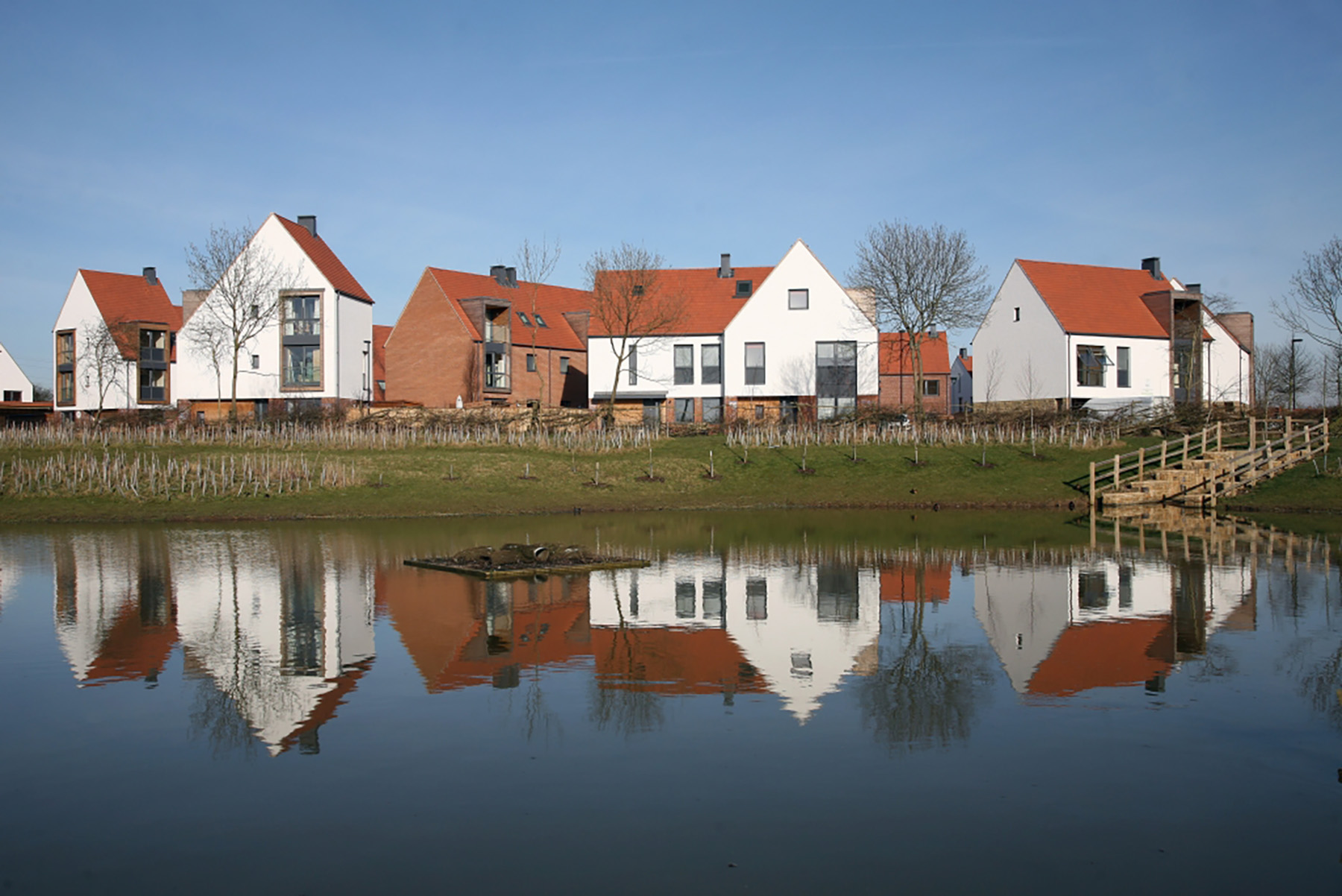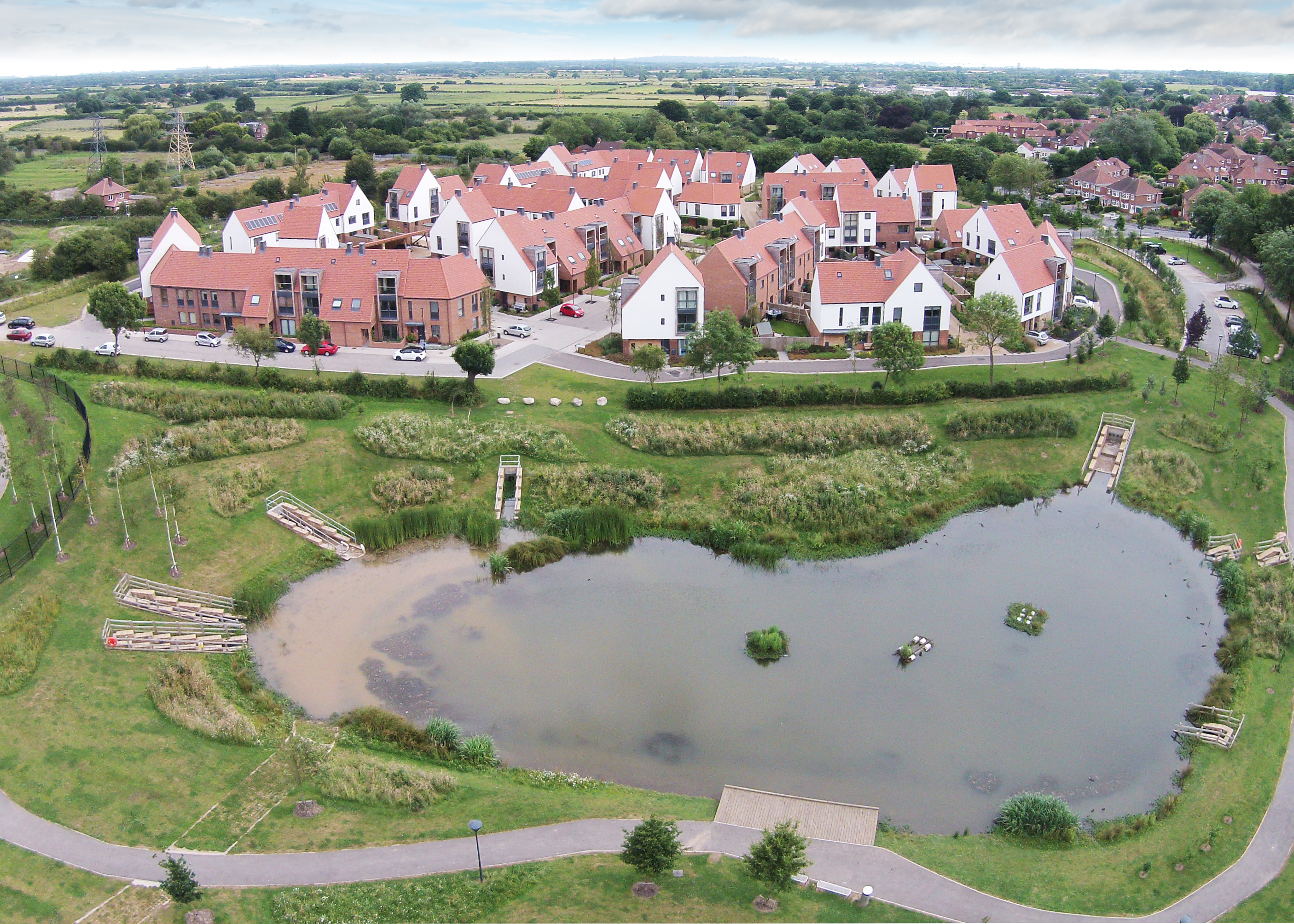Derwenthorpe: can a successful community be planned?
Posted on 12 Mar 2019 Categories: Blog, Housing, New economic models, The place we want
by Steven Burkeman
In 1901, Joseph Rowntree began creating what was to become the village of New Earswick, 2½ miles north of York. Today, New Earswick is a thriving mixed community of some 2,700 people, with a range of community facilities. Over 80 years later, the trustees of the Joseph Rowntree Housing Trust (JRHT), who had inherited responsibility for New Earswick, took on the challenge of planning and developing, Derwenthorpe, what they described as a ‘New Earswick for the 21st century’.

Two miles east of the centre of York, Derwenthorpe is a newly created village of 540 homes spread over a 21.7-hectare site; residents began moving in in 2012. Sixty per cent of the homes are for sale, and 40 per cent are rented (25 per cent) or shared ownership (15 per cent), with the social housing ‘pepper-potted’ around the estate. All the houses are built to the same ‘Lifetime Homes’ standards. As well as adapting to the needs of residents as they age, they are highly suitable for younger residents with disabilities – a significant number of residents living in social housing at Derwenthorpe have one or more children who use a wheelchair.
Derwenthorpe was planned by JRHT as a socially mixed and environmentally sustainable community. To what extent has this been achieved? Is it even possible for a successful community to be planned in this way? This article will attempt to answer these questions – questions of much wider interest than one small village near York. The development has won many awards, and attracted much interest from people considering similar initiatives. What can they learn from Derwenthorpe?
Does Derwenthorpe work as a socially mixed community?
JRHT exists to house poor people, so why did it decide to make Derwenthorpe a mixed income community? The research evidence on mixed income communities is … well, mixed. In March 2006, after the decision had been taken by JRHT to embark on the development which became Derwenthorpe, Joseph Rowntree Foundation (JRF) published an overview of research evidence which concluded that:
‘Mixed income communities studied were overwhelmingly judged successful; they were not characterised by the problems often linked with exclusively low-income areas. The schemes had generally met the expectations of developers, residents and housing managers and had become pleasant places to live, learn and work.’
Just over a year later, however, JRF published research which concluded that ‘mixed neighbourhoods treat a symptom of inequality, not its cause, and the problem is poverty and not where people live’. The report found evidence that ‘living with similar people – for both rich and poor – can generate some advantages’.
How has it played out in Derwenthorpe specifically? The pepper-potting of tenures, in homes built to identical standards, has been somewhat undermined by the creation of two three-storey blocks of flats which will house a concentration of social housing tenants. In any case, situating poorer and more affluent people next door to each other is no guarantee that they will mix socially.
There is now a very active ‘community activity network’, a loose and open group seeking to support residents organising activities at Derwenthorpe. A monthly calendar covering all activities is distributed to all residents, and where possible, to immediately neighbouring streets – while there is a very strong sense of place, there is also a strong feeling that we should be welcoming to our neighbours. Nevertheless, the growing number of activities that happen every week in community rooms at the energy centre (where the boilers fuelling the district heating system are based – see below) do tend to be dominated by home-owners.
The design for Derwenthorpe included considerable communal areas and green space, including ponds, greens, courtyards, a football/basket-ball court, two playgrounds, and a ‘fun and fitness’ course aimed at adults, well used by residents and by many people from neighbouring communities. These provide ample opportunities for people to meet each other in pleasant surroundings and functional spaces.
But some of the community facilities have proved inadequate – the largest meeting room at the energy centre can only accommodate 60 people, far too small for the already approximately 1,000 people living at Derwenthorpe – and others are lacking. Currently there is no provision for a café, though one has opened nearby, attached to the local library. Nor are there any shops, though there are ‘local’ versions of Sainsburys and the Co-op within walking distance for most residents.
Shared governance could help develop a stronger sense of community. When planning New Earswick, Joseph Rowntree had strong views on how the village should be run, writing:
‘I should regret if there were anything in the organisation of these village communities that should interfere with the growth of the right spirit of citizenship, or be such that independent and right-minded men and women might resent. I do not want to establish communities bearing the stamp of charity but rather of rightly ordered and self-governing communities – self-governing, that is, within the broad limits laid down by the Trust.’
As the development nears completion, JRHT has taken the initiative in working with the residents’ association to create a mechanism for shared governance at Derwenthorpe. Among other things, this will give residents a significant ‘say’ in the spending of the monthly estate charge paid by residents towards maintenance of the environment, and in the roles of the fulltime manager and caretaker who are based on site.

Is Derwenthorpe environmentally sustainable?
Many features of the design at Derwenthorpe are intended to contribute to its environmental sustainability. The first 60 houses were equipped with Mechanical Ventilation & Heat Recovery systems (MVHR) which recycle heat (later houses have MEV systems). Many were designed with ‘winter gardens’, trapping cold air in winter, thereby reducing heating costs, and acting as ‘heat sinks’ in summer. The houses are all very well sealed. Heating is provided by means of a district heating system, which pumps hot water to all homes, which are equipped with heat exchangers. As mentioned, there is an energy centre which houses the boilers – which burn locally grown woodchip where possible, and also gas. As we have seen, the centre doubles as a community facility. All homes have fibre to the home, providing super-fast broadband. The ratio of green space to buildings is generous.
Because Derwenthorpe was built on what had been fields, flood prevention measures were essential. Sustainable Drainage Systems (SuDS) include two ponds, which provide a home for ducks, swans and geese as well as providing a place for surplus water to go. These systems were well and truly tested in December 2015, when much of the rest of York was badly affected by flooding.
On the transport side, there’s a car sharing club, and newcomers receive bike vouchers or travel passes – all designed to discourage car use. The development is built on both sides of Sustrans Route 66, formerly a railway line (the Derwent Valley Light Railway – hence the name ‘Derwenthorpe’), so cycling or walking to and from town is a viable option for many residents. There is a good bus service from the neighbouring village of Osbaldwick into town, and an hourly service from Derwenthorpe itself, via a large supermarket.
Inevitably, not everything has gone to plan. There were problems with the sourcing and installation of the MVHR systems provided in the first 60 houses – problems which are still in the process of being remedied. As a result, JRHT decided not to provide them in subsequent phases – which seems a pity, given that such systems can work well and make a significant contribution to reducing heating costs. Lack of control has created some dissatisfaction. JRHT negotiated multi-year ‘sole provider’ contracts with companies to run the district heating system and the ‘fibre to the home’ service (which covers telephone, TV and broadband). This has removed residents’ ability to switch providers, which troubles some of them.
Nevertheless Derwenthorpe residents do have a lower power carbon footprint than the national average, though the travel component of their footprint is significantly higher. Though the cycle network and buses are well used and appreciated, the car club scheme is used much less, and the policy of encouraging ownership of only one car per household has led to some tensions in the community. The village’s location on the outskirts of York means that people’s commuting patterns are hard to change, and their wider travel footprints, for example for holidays, have not been affected.
A viable model?
The development at Derwenthorpe has been the subject of a longitudinal research project, based at the University of York, the results of which have been published recently. Called Making a sustainable community: life in Derwenthorpe, York, 2012–2018, it found high levels of satisfaction among residents, and concluded that
‘mainstream housing developers can successfully deliver sustainable homes and communities at scale that produce high-quality living environments. However, different levels of buy-in from residents mean that environmental and social measures need to be built into the model as far as possible from the outset.’
Among other things, it recommends that housing providers should work with resident groups ‘to set up inclusive governance structures to promote the long-term social sustainability of communities’.
Derwenthorpe was a major undertaking for a small housing association, and it is unlikely that JRHT would attempt anything on a similar scale in the near future. But, while the development has not been without its challenges, those who live here are overwhelmingly happy that they do.
Steven Burkeman is a trustee of JRHT (and of JRF), one of those who took the decision to proceed with the development of Derwenthorpe, where he now lives. He writes here in a personal capacity.
Want to keep up-to-date with more articles like this? Sign up to our newsletter.
Posted on 12 Mar 2019 Categories: Blog, Housing, New economic models, The place we want

Housing associations are well-placed to attempt the creation of mixed communities, as they have the necessary ethos. Also, while they wish to make a surplus, they do not aspire to the gob-smacking profit margins that private developers have come to expect, and the consequent obscene bonus payments to higher management.
To extend the development of mixed communities beyond those initiated by housing associations or local authorities, it will be essential to review the planning framework which requires a percentage of affordable (not even social) housing in all housing developments. The present system has no teeth and is widely abused by developers arguing for reductions in the percentage of affordable housing to be provided for reasons which are insufficiently challenged by planning departments and councillors. Or, instead of the pepper-potting approach such as at Derwenthorpe (encouraged by City of York Council), affordable housing is concentrated in the least attractive corner of a site, or blocks of flats have separate entrances for private and “social” tenants.
JRHT has a long history of innovative thinking and action on housing. Long may it continue.